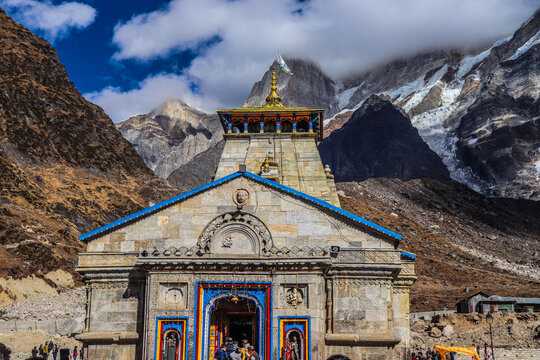
11-Jun-2023 , Updated on 6/12/2023 6:42:38 AM
Kedarnath- The History of powerful space in India
In the scenic Garhwal Himalayas of Uttarakhand, India, lies a place of great spiritual significance and natural beauty—Kedarnath. Perched at an altitude of 3,583 meters (11,755 feet), this ancient temple town is home to one of the most revered Hindu pilgrimage sites, the Kedarnath Temple. The history of Kedarnath is steeped in legend and mythology, making it a powerful space that has captivated the hearts and minds of devotees for centuries.
The origin of Kedarnath dates back to the ancient Hindu epic, the Mahabharata. According to the legend, after the great Kurukshetra war, the Pandavas sought the blessings of Lord Shiva to atone for their sins. Lord Shiva, however, did not wish to meet them and decided to hide in the form of a bull. The Pandavas, led by Yudhishthira, followed the bull to various places until they finally reached Kedarnath. Recognizing the true form of Lord Shiva, they requested him to stay in Kedarnath for the benefit of humanity. Lord Shiva granted their wish and took the form of a Jyotirlinga (a radiant lingam), which is enshrined in the Kedarnath Temple.
The Kedarnath Temple, believed to have been built by the Pandavas, has withstood the test of time and nature. It is a magnificent stone edifice adorned with intricate carvings and surrounded by breathtaking mountain peaks. The temple is considered one of the twelve Jyotirlingas in India, which are believed to be the most sacred abodes of Lord Shiva. The spiritual energy that emanates from this sacred space is said to be immensely powerful and transformative.
Over the centuries, Kedarnath has attracted millions of devotees from all over the world. Pilgrims undertake a rigorous trek of approximately 16 kilometers (10 miles) from Gaurikund to reach the temple, braving challenging terrain and adverse weather conditions. This arduous journey is seen as a test of devotion and a way to purify one's soul. The experience of trekking through the majestic Himalayas and reaching the divine abode of Lord Shiva is considered a transformative and life-altering experience for many.
Apart from its religious significance, Kedarnath is also known for its natural beauty and serene surroundings. The temple town is nestled in the midst of snow-capped peaks, lush meadows, and gushing rivers. It is located near the Mandakini River, which is believed to have originated from Lord Shiva's locks. The awe-inspiring landscape adds to the mystical aura of the place, making it a must-visit destination for nature lovers and spiritual seekers alike.
However, Kedarnath has also faced its fair share of challenges throughout history. In June 2013, the region was struck by a devastating natural disaster—the Kedarnath flash floods. Heavy rainfall caused massive landslides and flash floods, resulting in the loss of thousands of lives and extensive damage to infrastructure. The Kedarnath Temple was also severely affected, with parts of it being washed away by the raging waters. The tragedy sent shockwaves across the nation and highlighted the need for better disaster management and conservation measures in the region.
In the aftermath of the disaster, the government and various organizations launched extensive reconstruction efforts to restore the Kedarnath Temple and revive the surrounding area. The resilience and determination of the people involved in the restoration work were truly remarkable. The restored Kedarnath Temple stands today as a symbol of hope and a testament to human endeavor as well as the unwavering faith of the devotees.
The reconstruction of Kedarnath Temple involved a meticulous process that aimed to preserve the ancient architectural style while incorporating modern techniques to enhance its structural integrity. Skilled artisans and craftsmen worked tirelessly to recreate the intricate carvings and restore the temple's grandeur. The project also focused on improving infrastructure, including the construction of better roads, bridges, and facilities to accommodate the increasing number of pilgrims.
The revitalization of Kedarnath has not been limited to the physical aspects alone. Efforts have also been made to ensure the sustainable development of the region while preserving its natural beauty and ecological balance. The authorities have implemented measures to regulate tourism and pilgrimage activities, such as controlling the number of visitors and enforcing eco-friendly practices. These initiatives aim to protect the fragile ecosystem of the Himalayas and maintain the sanctity of the space.
Today, Kedarnath continues to be a powerful space that attracts devotees, nature enthusiasts, and adventurers alike. The annual pilgrimage to the temple remains a deeply spiritual and transformative experience for millions of people. The breathtaking beauty of the surroundings, the divine aura of the temple, and the challenging trek all contribute to the profound impact that Kedarnath has on visitors.
The history of Kedarnath is a testament to the enduring power of faith and the ability of humans to overcome adversity. It is a reminder of the rich cultural and spiritual heritage of India and the deep connection between humans and nature. As Kedarnath stands tall once again, it serves as a beacon of hope and a place of solace for all those who seek a connection with the divine and a deeper understanding of themselves.

SEO and Content Writer
I am Drishan vig. I used to write blogs, articles, and stories in a way that entices the audience. I assure you that consistency, style, and tone must be met while writing the content. Working with the clients like bfc, varthana, ITC hotels, indusind, mumpa, mollydolly etc. has made me realized that writing content is not enough but doing seo is the first thing for it.
Comments
Join Our Newsletter
Subscribe to our newsletter to receive emails about new views posts, releases and updates.
Copyright 2010 - 2025 MindStick Software Pvt. Ltd. All Rights Reserved Privacy Policy | Terms & Conditions | Cookie Policy